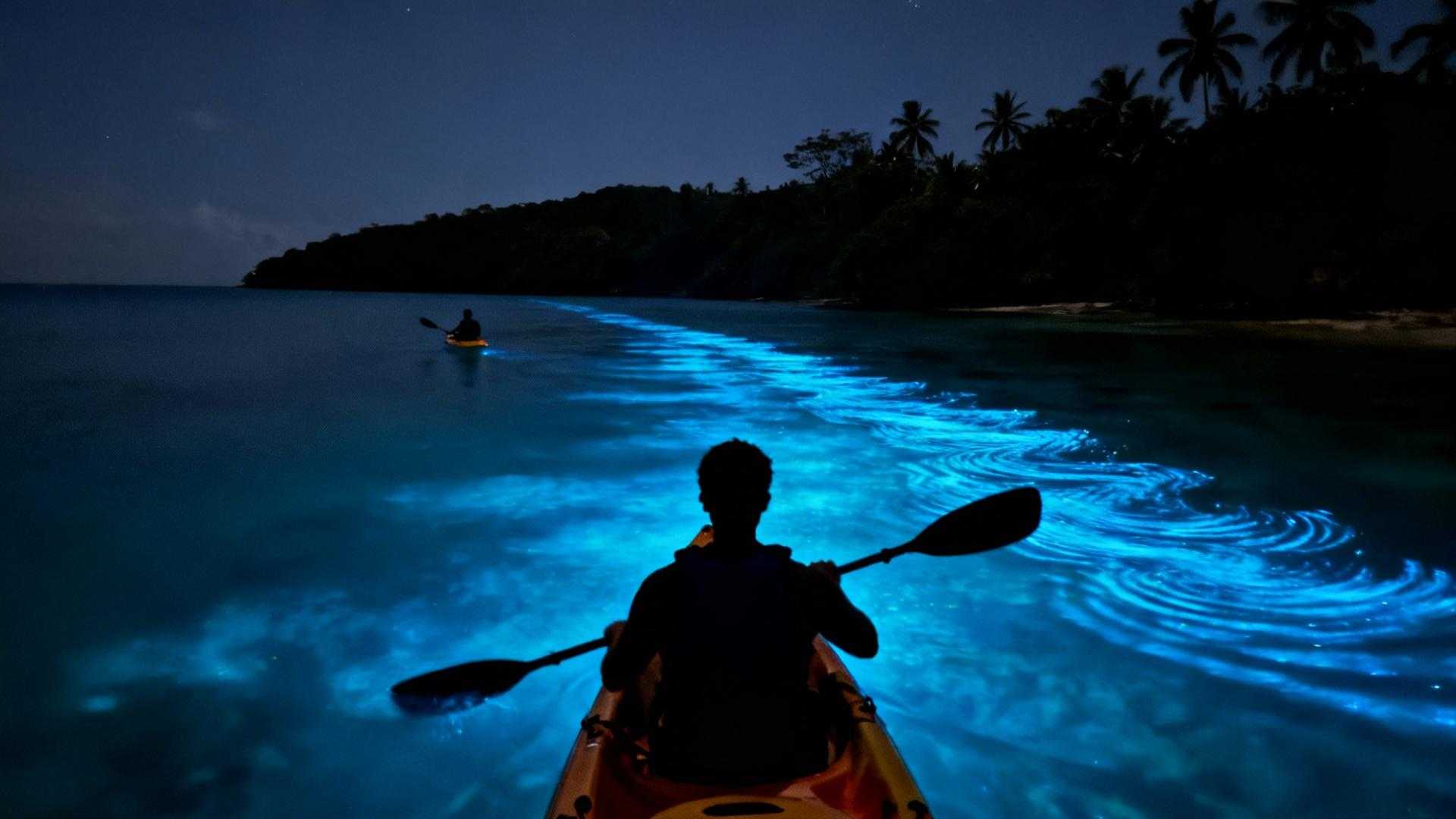I paddled into Mosquito Bay on a moonless October night, and the water around my kayak exploded into liquid starlight. Twenty years photographing bioluminescent bays across the Caribbean had prepared me for a faint glow, maybe some sparkles if I got lucky. What I witnessed in Vieques that evening—700,000 dinoflagellates per gallon creating the brightest bioluminescent water on Earth—changed everything I thought I knew about nature’s light shows.
The bay earned its Guinness World Record in 2006 not through marketing hype, but through measurable scientific superiority. While mainland Puerto Rico’s famous Laguna Grande attracts crowds with its novelty, Mosquito Bay operates on an entirely different ecological scale.
Every stroke of my paddle released cascading blue-green fire that trailed behind like comet tails. My guide, a third-generation Vieques resident, whispered that locals call it “agua que brilla”—water that shines. That night, I understood why this tiny island community guards their bay so fiercely.
The scientific phenomenon that creates living light
How 700,000 organisms transform water into starlight
The dinoflagellate Pyrodinium bahamense thrives in Mosquito Bay’s unique conditions—shallow depth averaging just 3 feet, protective mangrove barriers, and complete absence of light pollution. These microscopic organisms produce bioluminescence a hundred times larger than their body size when disturbed, creating the most intense natural light show on the planet.
Why this bay outperforms every global alternative
Scientific measurements confirm what your eyes can’t believe: Mosquito Bay contains three times more bioluminescent organisms than Laguna Grande in Fajardo and nearly five times more than Jamaica’s Luminous Lagoon. The bay’s National Natural Landmark status since 1980 protects the delicate ecosystem that makes this concentration possible. The narrow mouth and surrounding mangroves create a natural sanctuary where dinoflagellates flourish year-round.
What I learned from locals protecting their liquid starlight
The Vieques community’s conservation approach
Swimming in Mosquito Bay is strictly forbidden—not to limit your experience, but to preserve it for decades to come. Sunscreen chemicals and insect repellent destroy the organisms that create the glow. Local kayak operators, many whose families have lived on this 9,000-resident island for generations, educate visitors on why protection matters more than Instagram moments.
How former Navy land became an ecological miracle
When the U.S. Navy departed Vieques in 2003, the island gained something unexpected: decades of restricted access had accidentally preserved one of Earth’s rarest ecosystems. Today, the same protective approach that Vietnamese island communities use for marine sanctuaries guides Vieques tourism—controlled access, eco-education, and community-first conservation.
The transformation that surprised me most
Why new moon timing changes everything
I returned to Mosquito Bay during three different moon phases before I understood the locals’ obsession with lunar calendars. The new moon period between October 21-23, 2025 offers pitch-black conditions where bioluminescence reaches maximum visibility. Full moon nights, while romantic, wash out the very phenomenon you came to witness.
The moment that redefined natural wonders for me
Halfway through my second tour, our guide stopped paddling and asked us to place our hands in the water. The bioluminescence clung to our fingers like living stars, dripping blue fire back into the bay. That tactile connection—touching light itself—revealed something no photograph could capture. Like discovering tiny islands that deliver extraordinary experiences, Mosquito Bay proves that nature’s most powerful moments happen in protected, intimate spaces.
The practical wisdom that makes this accessible
How to reach Vieques without complicated logistics
Ferry service from Ceiba, Puerto Rico costs $2 per person and runs multiple times daily. The 30-minute crossing delivers you to an island where Spanish heritage blends with Caribbean laid-back culture. No passport required for U.S. citizens—this is domestic travel to an international-caliber natural wonder.
Why kayak tours protect what speedboats destroy
Motorized boats create wake and noise that disturbs both dinoflagellates and the mangrove ecosystem. Kayak-only access at $45-60 per person ensures you experience the bay as it’s meant to be witnessed—in respectful silence, moving slowly through water that responds to every gentle stroke. Like underwater sculpture gardens that become living reefs, Mosquito Bay thrives because human interaction follows nature’s pace, not our convenience.
I’ve timed every Caribbean trip around new moon phases since that first Vieques night. The bay taught me that the brightest natural wonders exist in the darkest conditions, protected by communities who understand that true magic requires both sharing and safeguarding. When 700,000 organisms per gallon create liquid starlight, you don’t just witness bioluminescence—you discover why some places deserve protection more than popularity.
Common questions about visiting Mosquito Bay
Can I visit Mosquito Bay year-round?
Yes, bioluminescence occurs throughout the year, but visibility peaks during new moon periods with clear weather. February through April offers the most consistent conditions, though October through December provides excellent viewing with fewer crowds and comfortable water temperatures around 82°F.
Why can’t I swim in the bay?
Swimming is prohibited to protect the dinoflagellate population from harmful chemicals in sunscreen, lotions, and insect repellent. Even biodegradable products contain compounds that damage these delicate organisms. Kayaking provides intimate access while preserving the ecosystem that creates the bioluminescence.
How does Mosquito Bay compare to other bioluminescent locations?
Scientific measurements confirm Mosquito Bay contains the highest concentration of bioluminescent organisms globally—approximately three times more than Laguna Grande in Fajardo and significantly brighter than bays in Jamaica or Vietnam. The combination of protective mangroves, shallow depth, and strict conservation creates unmatched intensity and year-round reliability.
